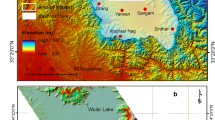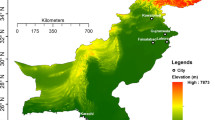Abstract
Thermal infrared images from Landsat satellites are used to derive land surface temperatures (LST) and to calculate the intensity of the surface urban heat island (UHI) during the summer season in and around the city of Brno (Czech Republic). Overall relief, land use structure, and the distribution of built-up areas determine LST and UHI spatial variability in the study area. Land-cover classes, amount and vigor of vegetation, and density of built-up areas are used as explanatory variables. The highest LST values typically occur in industrial and commercial areas, which contribute significantly to surface UHI intensity. The intensity of surface UHI, defined as the difference between mean LST for urban and rural areas, reached 4.2 and 6.7 °C in the two images analyzed. Analysis of two surface characteristics in terms of the amount of vegetation cover, represented by normalized difference vegetation index, demonstrates the predominance of LST variability (56–67 % of explained variance) over the degree of urbanization as represented by density of buildings (37–40 % of LST variance).







Similar content being viewed by others
References
Arnfield AJ (2003) Two decades of urban climate research: a review of turbulence, exchanges of energy and water, and the urban heat island. Int J Climatol 23:1–26
Barsi JA, Schott JR, Palluconi FD, Hook SJ (2005) Validation of a web-based atmospheric correction tool for single thermal band instruments. Proc SPIE 5882:136–142
Bičík I, Jeleček L (2009) Land use and landscape changes in Czechia during the period of transformation 1990–2007. Geografie 4:263–281
Brázdil R, Chromá K, Dobrovolný P, Tolasz R (2009) Climate fluctuations in the Czech Republic during the period 1961–2005. Int J Climatol 2:223–242
Chander G, Markham BL (2003) Revised Landsat-5 TM radiometric calibration procedures and postcalibration dynamic ranges. IEEE T Geosci Remote 41:2674–2677
Chander G, Markham BL, Helder DL (2009) Summary of current radiometric calibration coefficients for Landsat MSS, TM, ETM+, and EO-ALI sensors. Rem Sens Environ 113:893–903
Cheval S, Dumitrescu A (2009) The July urban heat island of Bucharest as derived from modis images. Theor Appl Climatol 96:145–153
Dash P, Göttsche FM, Olesen FS, Fischer H (2002) Land surface temperature and emissivity estimation from passive sensor data: theory and practice—current trends. Int J Rem Sens 13:2563–2594
Dousset B, Gourmelon F (2003) Satellite multi-sensor data analysis of urban surface temperatures and landcover. ISPRS J Photogramm 58:43–54
Dousset B, Gourmelon F, Laaidi K, Zeghnoun A, Giraudet E, Bretin P, Mauri E, Vandentorren S (2011) Satellite monitoring of summer heat waves in the Paris metropolitan area. Int J Climatol 31:313–323
Gallo KP, Owen TW (1999) Satellite-based adjustments for the urban heat island temperature bias. J Appl Meteor 38:806–813
Grimmond S (2006) Progress in measuring and observing the urban atmosphere. Theor Appl Climatol 84:3–22
Hart MA, Sailor DJ (2008) Quantifying the influence of land-use and surface characteristics on spatial variability in the urban heat island. Theor Appl Climatol 95:397–406
Hu Y, Jia G (2010) Influence of land use change on urban heat island derived from multi-sensor data. Int J Climatol 9:1382–1395
Kato S, Yasushi Y (2005) Analysis of urban heat island effect using ASTER and ETM+ Data: separation of anthropogenic heat discharge and natural heat radiation from sensible heat flux. Rem Sens Environ 99:44–54
Lambin E, Geist H (eds) (2006) Land-use and land-cover change. Local processes and global impacts. Springer, Berlin
Li F, Jackson TJ, Kustas WP, Schmugge TJ, French AN, Cosh MH, Bindlish R (2004) Deriving land surface temperature from Landsat 5 and 7 during SMEX02/SMACEX. Rem Sens Environ 92:521–534
Nichol JE (1998) Visualization of urban surface temperatures derived from satellite images. Int J Rem Sens 9:1639–1649
Oke TR (1997) Urban climates and global environmental change. In: Thompson RD, Perry A (eds) Applied climatology. Routledge, London, pp 273–287
Oke TR (2006) Initial guidance to obtain representative meteorological observations at urban sites. IOM Report No. 81, WMO/TD. No. 1250. World Meteorological Organization, Geneva
Pongracz R, Bartholy J, Dezso Z (2006) Remotely sensed thermal information applied to urban climate analysis. Adv Space Res 37:2191–2196
Qin Z, Karnieli A, Berliner P (2001) A mono-window algorithm for retrieving land surface temperature from Landsat TM data and its application to Israel–Egypt border region. Int J Rem Sens 18:3719–3746
Ridd MK (1995) Exploring a V-I-S (vegetation–impervious surface–soil) model for urban ecosystem analysis through remote sensing: comparative anatomy for cities. Int J Rem Sens 16:2165–2185
Snyder WC, Wan Z, Zhang Y, Feng Y (1998) Classification-based emissivity for land surface temperature measurement from space. Int J Rem Sens 19:2753–2774
Sobrino JA, Jiménez-Muñoz JC, Paolini L (2004) Land surface temperature retrieval from LANDSAT TM 5. Rem Sens Environ 90:434–440
Stathopoulou M, Cartalis C (2007) Daytime urban heat islands from Landsat ETM+ and Corine land cover data: an application to major cities in Greece. Sol Energy 81:358–368
Stewart ID (2011) A systematic review and scientific critique of methodology in modern urban heat island literature. Int J Climatol 2:200–217
Tan KC, Lim HS, MatJafri MZ, Abdullah K (2010) Land surface temperature retrieval by using ATCOR3_T and normalized difference vegetation index methods in Penang Island. Am J Appl Sci 5:717–723
Tomlinson CJ, Chapman L, Thornes JE, Baker CJ (2010) Derivation of Birmingham’s summer surface urban heat island from MODIS satellite images. Int J Climatol. doi:10.1002/joc.2261
Unger J (2004) Intra-urban relationship between surface geometry and urban heat island: review and new approach. Clim Res 27:253–264
Voogt JA, Oke TR (2003) Thermal remote sensing of urban climates. Rem Sens Environ 86:370–384
Weng Q (2009) Thermal infrared remote sensing for urban climate and environmental studies: methods, applications, and trends. ISPRS J Photogramm 64:335–344
Weng Q, Lu D, Schubring J (2004) Estimation of land surface temperature–vegetation abundance relationship for urban heat island studies. Rem Sens Environ 89:467–483
Yuan F, Bauer ME (2007) Comparison of impervious surface area and normalized difference vegetation index as indicators of surface urban heat island effects in Landsat imagery. Rem Sens Environ 106:375–386
Acknowledgements
This study was prepared within the project GA205/09/1297 “Multilevel analysis of the urban and suburban climate taking medium-sized towns as an example” granted by Czech Science Foundation. Tony Long (Svinošice, Czech Republic) is acknowledged for English style corrections.
Author information
Authors and Affiliations
Corresponding author
Rights and permissions
About this article
Cite this article
Dobrovolný, P. The surface urban heat island in the city of Brno (Czech Republic) derived from land surface temperatures and selected reasons for its spatial variability. Theor Appl Climatol 112, 89–98 (2013). https://doi.org/10.1007/s00704-012-0717-8
Received:
Accepted:
Published:
Issue Date:
DOI: https://doi.org/10.1007/s00704-012-0717-8




